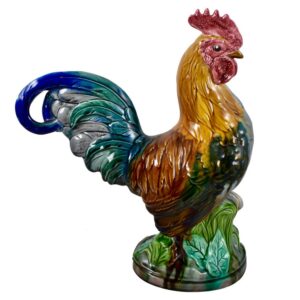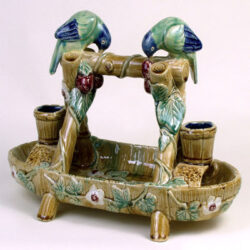A Word About Reproductions & Restoration

Minton Majolica John Henk Rooster, 1910
As the popularity of Victorian Majolica and English Staffordshire pottery increases, reproductions are bound to turn up on the market. Some reproductions have a charm of their own, but it is important to distinguish these newer items from original pieces. If we begin to see multiples of an older piece hit the market, we can assume that item has been reproduced. With continued viewing and handling of antique ceramics, the collector comes to know the differences between the original and the copy.
Identifying Reproductions:
In reproductions, the glaze can be less intense and less uniform over the piece.
Consider the weight of the body – too light or too heavy?
Does the glaze feel too warm to the touch? Properly fired pottery has a cool temperature.
Always check for a mark on the undersurface. Is the mark fraudulent or non-existent?
In repros, the modeling of a piece can be an accurate copy of the original but the details may be less exact and the glazing may not be appropriate.
Some complex pieces are not reproduced with all the segments, such as a cache pot without the underplate.
Majolica undersurfaces are almost always glazed, including the outer rim – with repros there may be no glaze there.
Repros may have hollow handles indicating a poured slip mold or they may not be glazed fully on the interior.
Spotting damage and restoration:
The rarity of the item, any damage, and the extent and quality of any restoration will affect value. A poorly executed restoration will lower the
value, while a professional, well done job will add to the value.
Damage:
Look at the most vulnerable areas first: rims, spouts, handles, footings and high points. Run a finger over these areas to detect imperfections.
Look for stable hairlines, obvious cracks, chips and prominent crazing or staining. A cracked item will not “bell” when tapped.
Restoration:
Look for slight changes in color, a peeling finish or a dusty coating.
Look for an area with an absence of normal crazing.
Feel for a change in texture, restored areas can have a relatively rough feel.
Feel for a change in hardness. Restorations are often made using a softer acrylic material. Unrestored glaze will feel hard like glass and cooler to
the touch than a restored area.
Below are a few comparisons of authentic pieces next to some reproductions seen recently on the market .
19th C. George Jones Strawberry Server next to the reproduced server.


19th C. Minton Cheese Stand next to a modern copy.


19th C. Wedgwood Quail Game Server next to an Asian copy for the Western market.


Antique Brownfield Monkey & Bird pitcher next to a terrible copy.



